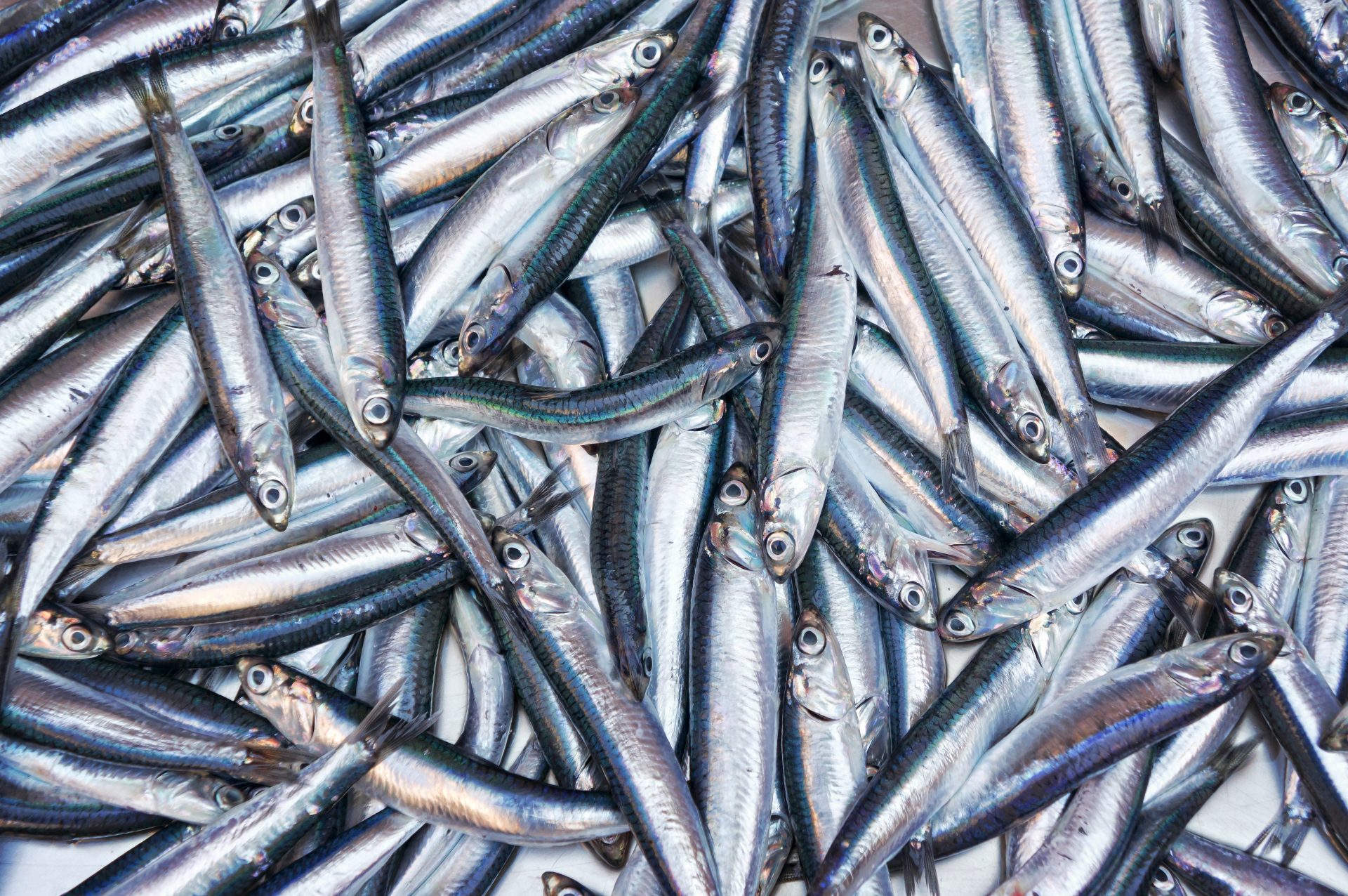The quest for more sustainable caviar
For the glory of acquiring highly prized sturgeon eggs, countless clashes and crimes have transpired across the globe, from coffin-crammed capers to revisionist religion. Salt-cured sturgeon roe — better known as caviar — is an epicurean delicacy that first appeared in Greek writings of 3rd Century BCE and has been de rigueur in the lifestyles of the rich and famous ever since, thanks to the relative rarity of the slow-growing fish and the work required to harvest its eggs.
But these days, this delicacy is going more mainstream: Next-generation caviar experiences trade the luxury provision’s classical utensils, whether mother-of-pearl spoon or blini pancake, for the likes of a Pringles potato chip. You might see caviar mixed, perhaps blasphemously, into the tartar sauce on a viral fish sandwich. It has also been fetishized in food festivals and social media through the caviar “bump”: a small dollop of so-called “black gold” placed on the back of the hand for consumption (a traditional tasting method used by fisherman and roe buyers). The global caviar market is expected to double in value to nearly $1 billion by 2033.
In a virtuous world, every last buttery bead would be sustainably produced through sturgeon aquaculture rather than from threatened wild populations, per the Convention on International Trade in Endangered Species (CITES). The global treaty was created in 1975 amid steeply declining populations of wild flora and fauna, and it has regulated international sturgeon trade since 1998 due to rampant harvesting, particularly in the Caspian Sea.
But sturgeon, though they hail from the Jurassic period, are now considered “on the brink of extinction.” As the largest freshwater fish in the world (though many also spend time in brackish or coastal marine environments), sturgeon can grow to be 12 to 15 feet in length, with roe comprising up to 30 percent of the female body weight. Given the money-making potential, the naturally vulnerable stocks have long been a prime target for over-exploitation. It may be no surprise that the International Union for the Conservation of Nature (IUCN) considers 27 sturgeon species “critically endangered,” including four natives of the Caspian Sea known to produce the world’s best caviar — Beluga (Huso huso), Russian (Acipenser gueldenstaedtii), Siberian (Acipenser baerii) and Sevruga (Acipenser stellatus). These particular species experienced a steep decline between 1978 and 1994.
Several sturgeon species can live 80 to 100 years, meaning they are slow to reach reproductive age (10 to 12 years on average). These long lifespans mean reckless, numbers-driven poaching is especially destructive, since juveniles are bound to fall accidental prey. Simply put, wild sturgeon are being poached before they can produce eggs to perpetuate the species. Dams and pesticide runoff from land agriculture are also culprits in the deterioration of wild sturgeon breeding grounds.
$1 billion
Expected value of the global caviar market by 2033
In 2004, the U.S. amended the Endangered Species Act to include Beluga sturgeon, motivating a corresponding ban on imported Beluga caviar in 2005 by U.S. Fish and Wildlife Service. (A separate CITES suspension on the trade of all wild sturgeon products from major stocks like the Caspian Sea was implemented in 2011.) Considering the nation’s historically voracious consumption of caviar — Food Republic reports that before the ban, “the United States imported four-fifths of the world’s caviar from Russia and other Central Asian countries” — the legislation was intended to reconstruct wild sturgeon populations, and maybe even repent for any role in the disappearance of these otherwise hardy, prehistoric fishes. Nevertheless, the IUCN reported earlier this year that “all Caspian sturgeon [continue to] have a declining population trend.”
So if caviar is booming but wild sturgeon are still dwindling, what’s a sustainably minded connoisseur to do? Here, we’ll explore how sturgeon farming has an important role to play and how U.S. caviar producers are satiating the craze for this beloved luxury provision while striving to maintain the health of the species. Spoiler alert: Your next tin of briny, buttery beads may not originate from sturgeon — or any other kind of fish — at all.
Caviar from a closed system
Currently, the global sturgeon aquaculture industry generates 380 tons of farmed caviar per year. As of 2018, there were 18 farms across the U.S. producing a total of 18 tons of caviar. The earliest sturgeon aquaculture dates back to 1869 Russia, but sturgeon farming began in the U.S. in 1979 as an academic pursuit at the University of California, Davis — and to this day, more than 80 percent of the domestic yield comes from aquaculture facilities in Northern California, where white sturgeon — Acipenser transmontanus, native to the west coast of North America — naturally occur in the Sacramento River and its tributaries.
During a recent visit to one of the nation’s oldest sturgeon farms, Tsar Nicoulai, near Sacramento, I watched as sturgeon slithered under a blanket of duckweed, occasionally breaking the verdant surface with a curious nose or the flap of a tail. Duckweed is a tiny aquatic plant that floats on the surface of the 40-year-old farm’s original aboveground tanks, helping cool the water and prevent evaporation. This aquaponic system, top-rated by the Monterey Bay Aquarium, recirculates water from the tanks through a separate, acre-size, U-shaped pond planted with water hyacinth, a botanical water filter. The pond acts as a filtration channel — as the water continues to flow around the loop, the cleaner it gets.
The low-tech setup can be considered a plant-driven prototype of the modern recirculating aquaculture system (RAS) in Tsar Nicoulai’s 54 newer tanks. A closed-loop technology borrowed from utility wastewater systems, RAS uses drum screens to filter out waste and scrap feed from the water before it’s recirculated through aboveground tanks, creating an aquatic environment that’s temperature-regulated and protected from competitors and predators. Not only do the valuable nutrients, minerals and oxygen stay within the system (instead of being absorbed by plants, as in the older system), but their levels can be adjusted. With this level of quality control, RAS is considered the gold standard in sustainable finfish aquaculture.
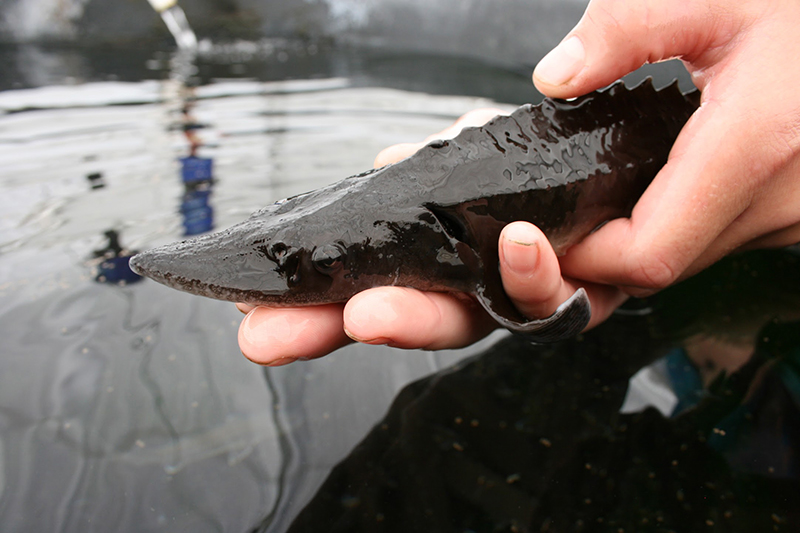
Simply defined as the farming of fish, shellfish and sea plants, aquaculture — in the case of sturgeon and other threatened sea life — can take the stress off wild populations and restore natural habitats, which in turn reinforces biodiversity, nature’s climate-change fixer. But not all systems are created equal. Offshore fish pens, used for raising fish in open water, are known to pollute the ecosystem with waste and leftover food, usually industrially produced. Shrimp ponds, which have displaced ecologically important mangrove forests, are frequently overstocked, leading to disease outbreaks and the overuse of antibiotics. (You can find these specimens in the frozen section at any big-box grocery store.) Bivalve aquaculture is considered more sustainable: Oyster farms in estuaries, for example, rely on ocean tides for oxygenation, require no additional inputs and are stocked with natural filter-feeders. When it comes to finfish, the mechanical filtration and circulation in RAS is the best way to reduce both water pollution and water usage.
Tsar Nicoulai, located just a few miles from the Sacramento River, the white sturgeon’s native environment, claims to have another edge on sturgeon welfare: As senior vice president Otto Szilagyi puts it, “the fish are being raised in their own merroir.” Tsar Nicoulai replenishes tank evaporation — an overall 8 percent loss per year, mostly due to the Sacramento Valley’s hot and sunny climate — from an aquifer that receives the same invigorating rainfall and pristine Sierra Nevada snowmelt that recharge the river. (While we know that sturgeon transmit stress to their eggs, the effect of “familiar” or “authentic” water on roe quality or fish “happiness” isn’t exactly proven.)
Putting sturgeon farming into practice
These kinds of systems are “really expensive to run, so you have to raise fish with a high return on investment,” explains Lianne Won Reburn, co-owner of Marshallberg Farm, a sturgeon aquaculture facility and boutique caviar producer in North Carolina. Marshallberg filters and recirculates 1 million gallons of water per hour through 40 tanks holding approximately 20,000 Russian sturgeon, which produce the variety of caviar known as Osetra. Marshallberg’s stock originated from fertilized eggs imported from a farm in Germany, which received its starter fish from the Caspian Sea before regulations were put in place.
A 2021 article penned by Reburn’s father, Marshallberg founder I.J. Won, opened with a joke — “How do you make a small fortune in aquaculture? You start with a large fortune” — and from there imparted a series of equally sobering reality checks, including how long the road to payoff actually is in sturgeon farming. (A decade or more, based on the fish’s slow maturation.) Despite this discouraging reality, Won, a retired geophysicist, staunchly believes that RAS “is the best [option] we have now to raise fish without polluting the environment.”
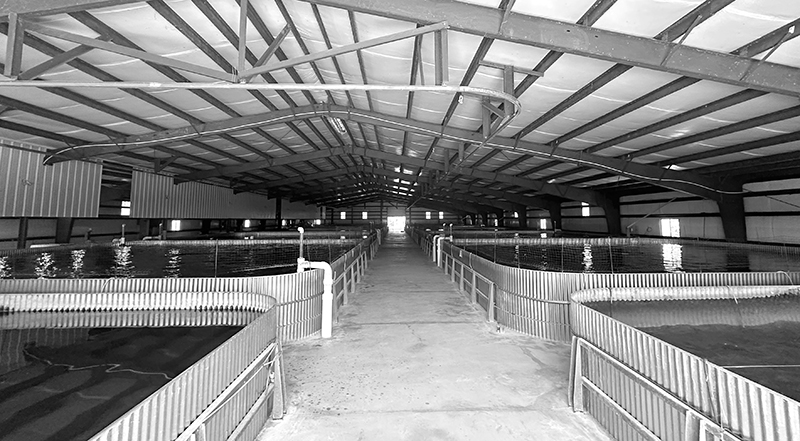
So what does life for farmed sturgeon look like? The roe we eat as caviar is unfertilized, but broodstock (originally sourced from the wild but now raised in hatcheries) is necessary to keep the operation going. Many caviar producers do everything in house, with a constant stock of both males and females. The first weeks after hatching are the “most difficult part of the hatchery process,” according to the Southern Regional Aquaculture Center, since fry will not survive in an aquaculture system on their own.
Once fish are old enough to be sexed by sight (around 4 years), the males are separated out and either raised as a source of milt (sperm) for the hatchery or processed for meat. Females, on the other hand, are raised to maturity. At farms like Tsar Nicoulai and Marshallberg, an ultrasound and biopsy will confirm when their roe is fit to collect. (No blind slaughter here, unlike the indiscriminate killing of fish regardless of sex or egg readiness that’s common in the illegal poaching trade.) The humane kill is swift — the fish is first stunned unconscious, then fatally struck on the head and carefully slit open along the belly for egg harvest.
A wealth of wild-caught alternatives
On a rainy spring day at The Caviar Co. tasting room in Tiburon, California, hackleback caviar is le bump du jour. The tiny, inky beads come from the shovelnose sturgeon (Scaphirhynchus platorynchus), one of the only sturgeon species that can be wild-harvested legally from its sparkling native habitat in the Tennessee River. Paddlefish (Polyodon spathula), a close cousin of the sturgeon native to the Mississippi River Basin, is also harvested for roe.
“These fish are the smallest of all sturgeon and produce eggs at a really young age [three years or younger],” explains Petra Higby, cofounder of The Caviar Co., which licenses caviar from sustainable sources all over the world for its private label. “Since the stocks are healthy, when hackleback and paddlefish are harvested, the species isn’t damaged.” That said, hackleback caviar production has been at a standstill since early 2023 because of low river levels, which cause the fish to migrate into deeper waters inaccessible to fishermen. “I just see this pause as a way to help the population get even stronger,” says Higby.
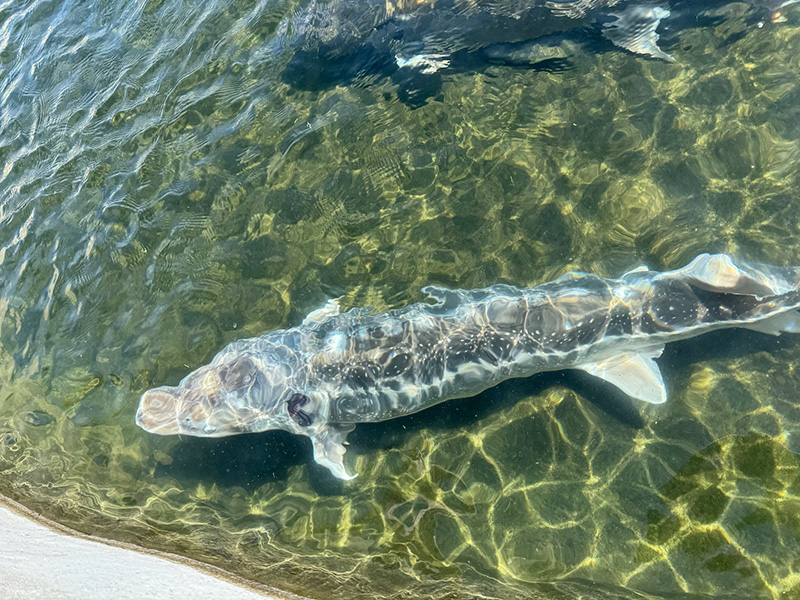
Still, there are other sustainable caviar substitutes that aren’t of the vulnerable sturgeon lineage. As this 2021 study confirms, aquaculture production for caviar alternatives from lumpfish, herring, tobiko, cod, shad and mullet have also increased in response to the drastic decline in wild sturgeon populations. Jewel-like salmon and trout roe are popular substitutes mainly produced from wild stocks in the U.S., Russia and Japan. These analogues, coming from comparatively common fish and lacking the same luxury reputation, command a fraction of what sturgeon caviar is worth, yet they are just as nutritive, packed with Vitamin B-12 and omega-3 fatty acids as well as antioxidants and anti-inflammatories.
Caviar without the kill?
California Caviar Co. founder Deborah Keane has been producing white-sturgeon caviar at her Sacramento-area aquafarm since 2007 for top chefs like Jacques Pépin and Dominique Crenn. But her latest project isn’t technically caviar at all. Keane, an apparent supertaster, is now “chief caviar officer” for the Davis, California-based food-tech startup Optimized Foods, where she is fine-tuning the brand’s new “cultured caviar” to mimic beluga’s “sea butter” flavor and grayish hue. If wild caviar is version 1.0, and farmed caviar is version 2.0, then vegan-friendly cultured caviar must be version 3.0.
In a process developed by scientist Ruihong Zhang of the University of California, Davis, and licensed by Optimized, cultured caviar is crafted from mycelium — the edible root structure of koji fungi — and cultivated on agricultural byproducts such as almond and pistachio hulls. They use a well-guarded process involving polyphenols to introduce color, flavor, texture and nutritional value (including omega-3 fatty acids akin to those in sturgeon caviar) during the growth process.
Optimized CEO Zane Starkewolfe is especially excited about upending the carbon equation. “The hulls aren’t going to be feeding cattle that create methane, they aren’t going to be rotting on a field creating methane, they’re not going into inefficient composting, or going into landfills or being burned,” he says. “They’re going into high-value nutritious foods.” Currently, Starkewolfe is drumming up endorsements for the cultured caviar from chefs at Michelin-starred restaurants, which he hopes will add legitimacy and momentum to an imminent direct-to-consumer product launch. Additionally, Zhang and Optimized are developing lab-grown caviar produced from sturgeon stem cells — version 3.5? — for a future release.
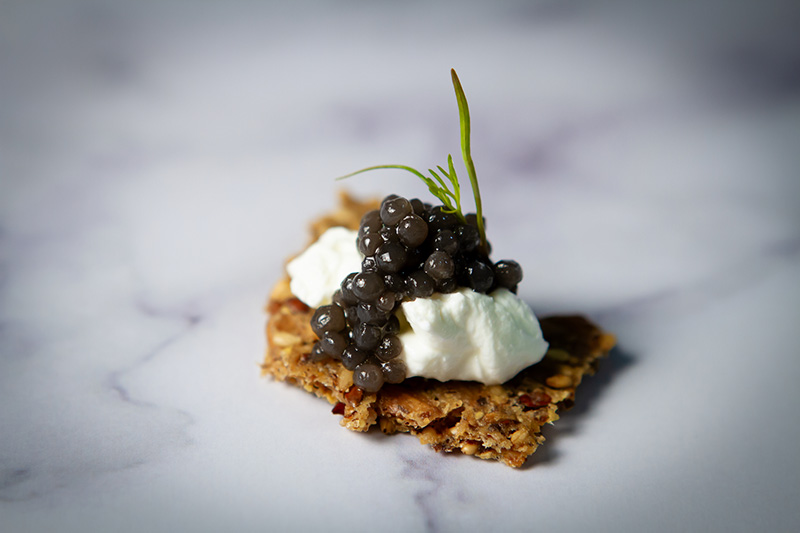
In addition to her work with Optimized, Keane owns the U.S. patent for a “no-kill” caviar method, and plans to start no-kill production at her sturgeon farm this year. Invented by marine scientist Angela Köhler of Germany’s Alfred Wegener Institute, the no-kill practice — known as the Vivace method — involves massaging the belly of a live sturgeon to release the roe. (Licensed to sturgeon farms by AWI, Vivace is considered to be slightly more ethical than obtaining eggs via C-section, another no-kill alternative that leaves the fish prone to infection.) The fish can then theoretically live to produce roe every 15 months, perhaps for decades.
“We’re mimicking nature,” says Keane. “We’re mimicking the conditions for females, which are responsible for continuing the species, to get their eggs fertilized.” Some claim that massaging the roe out of the belly cavity is akin to wild fish rubbing against a river rock to accomplish the same goal. But in Vivace, hormone therapy is first required to induce ovulation; since hormone-induced roe can be soft and mushy, “spherification” restores its structure through a calcium-solution rinse.
Toward traceability and transparency
Unsurprisingly, with as expensive a product as caviar, fraud is rampant. Poachers continue to operate in major sturgeon-producing countries, and traffickers will try to obscure supply chains in order to sell caviar under the guise of legality. A study by the World Wildlife Fund (WWF) found that the CITES labeling system, designed to ensure legal and traceable trade, lacks implementation. Most often, batch numbers are missing and claims of origin are erroneous — for instance, “aquaculture caviar [is] falsely sold as wild, but also wild caviar [is] ‘laundered’ as farmed to legalize it.” WWF’s caviar trade expert, Jutta Jahrl, has said caviar “is just so precious that it’s really worth trying illegal things.”
In the last few years, the U.S. has had its own cons to contend with. In 2022, a black-market caviar ring peddling roe from poached white sturgeon in Northern California was busted by the California Department of Fish and Wildlife after an 18-month investigation. And in 2021, a popular boutique caviar maker in the Sacramento region was outed through an anonymous whistleblower Instagram account for passing off foreign caviar under his own domestic estate label.
“The only way to beat the fraud is through your own education,” says The Caviar Co.’s Higby. “It’s really no different than tasting a flight of wine to find out if you prefer the pinot or the cabernet.” At her Tiburon tasting room, guided caviar flights help the consumer distinguish between, say, the umami nuttiness and firm egg of Kaluga and the Parmesan notes of softer Siberian caviar.
If you’re in the market for caviar, here are some tips to make an informed purchase: Research sturgeon farms, making sure their sustainability standards include pristine tank ecology, prioritized sturgeon welfare and even a clearly stated nose-to-tail approach. The proportion of sturgeon used for other purposes varies, but Marshallberg and Tsar Nicoulai, for example, use up to 80 percent — not just meat but also skin, which can be used for leather goods, and the sturgeon’s bladder, which can be used to make isinglass, a white-wine filter.
Be sure to also give tins the scrutiny they deserve. They should be vacuum sealed and stored at 28 to 34 degrees Fahrenheit — though experts recommend consuming caviar within three weeks of purchase, if properly stored, most unopened caviar can last up to six. The label should not be damaged and prove provenance by showing the six CITES labeling requirements, including species identification, country of origin and year of harvest. But then again, such due diligence by the consumer befits any premium purchase. As Lianne Reburn of Marshallberg Farm puts it, “Caviar will always be a luxury.”
Get the latest food news from FoodPrint.
By subscribing to communications from FoodPrint, you are agreeing to receive emails from us. We promise not to email you too often or sell your information.
Top photo: Tins with different grades of Osetra caviar. Courtesy of Marshallberg Farm.
More Reading
Salmon hatcheries: Unsuccessful conservation, insufficient regulation, and poor animal welfare
September 16, 2025
Why farmed seafood deserves an ethical debate
September 8, 2025
Think you’re eating local seafood? Beware of 'local-washing'
May 21, 2025
When bycatch is on the menu
December 12, 2024
Celebrating the Black history of oysters with chef Jasmine Norton
June 21, 2024
Oyster farming is the good kind aquaculture
April 2, 2024
A new report sheds light on the problems behind our imported shrimp
March 27, 2024
The collapse of fishing giant Blue Harvest exposes the weakness of catch share policies
November 20, 2023
Can We Really Eliminate Invasive Species by Eating Them?
July 19, 2023

